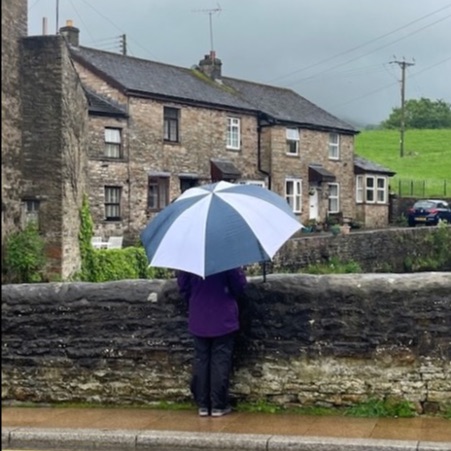Stormy Weather
Looking back over my photos of this year, I notice how many of them include umbrellas and raincoats. It seemed to be a particularly soggy spring and early summer. There’s my sister-in-law sheltering beneath a huge umbrella, and there’s Iain, peering into a muddy moat, water almost up to the level of the bridge he’s standing on. Though we eventually had some decent summer weather, it’s been a wet year.

In fiction, weather is one of the tools in the writer’s workbox that can be used to help create atmosphere. There’s a term for the giving of human emotions or actions to something non-human – the ‘pathetic fallacy.’ We talk of ‘miserable’ weather and the sun ‘smiling down’ or a ‘biting’ wind.

Just think of Jane Austen’s masterly scene in Pride and Prejudice when, after being caught in a rainstorm while walking to Mr Bingley’s house, Jane Bennet is confined to bed with a cold. Her sister, Elizabeth, doesn’t think twice about striding three miles across muddy fields to be with her. The reader pictures her exhilaration at being out in the fresh air, even in ‘dirty weather’, and admires her dash and her indomitable nature, as well as her concern for her feverish sister. Though the snobbish Miss Bingley makes disparaging remarks about Lizzy Bennet’s ‘petticoat, six inches deep in mud’, Mr Darcy refuses to join in. This is a key scene in the book. Mr Darcy has already begun to reassess his first, hasty and prejudiced opinion of Lizzy. He has noticed her ‘fine eyes’. The inclement weather helps to show the characters in a new light and emphasise their fluctuating thoughts and emotions.
I always enjoy writing a big scene, in which the narration reaches a turning point or climax – a quarrel, a declaration of love, a meeting or betrayal. I enjoy building up the tension and gathering into place the ingredients that will sweep the reader along.
I often use the weather to emphasise emotion within a scene. In the opening chapter of THE SECRETS BETWEEN US, Rowan’s marital home possesses a ‘claustrophobic flimsiness’. A window leaks, and the inherited furniture struggles to fit in the awkwardly angled rooms. The weather is ‘wintry’ and ‘misty’, the house chilly. The scene takes place just before Christmas, a time of happiness and family closeness, which contrasts with Rowan’s discontent and dissatisfaction. I wanted the cold wintriness to underline the sense of inertia and frozen emotions: though a part of her knows her marriage is going nowhere, Rowan hasn’t yet faced up to it.
Weather is only one of the items in a writer’s repertoire which can be used to create atmosphere. Time of day, the setting, whether it’s the interior of a house or out in the open air: all can heighten drama. Even a character’s clothing can suggest a mood. Though, at the Christmas party, the women are clad in a ‘delicious froth’ of evening frocks, Rowan, who usually dresses so well, is wearing a colour that doesn’t suit her. She has lost her compass. Later in the novel, her sister Thea is attending their father’s funeral. She is uncomfortable in her ‘best’ black coat but gains some solace from wearing her father’s cashmere scarf, with its familiar softness and scent.
In BEFORE THE STORM, I build up throughout the novel tension and a sense of foreboding around the character of Ruby’s Aunt Maude. Maude’s home, the East Anglian farm, Nineveh, is isolated and ramshackle. It is anything but a rural idyll. Dampness, clamminess, a growth of moss and fungi and the presence of a cold breeze all combine to suggest a lack of welcome and emphasise Ruby’s unease.
My new novel, A DIFFERENT WORLD, will be published in a few months’ time. In one of my favourite scenes in the book, I’ve used wind and rain to add drama and echo conflict, but it’s also there to give the characters something to battle against. I like to create female characters who are active rather than passive, who are practical and uncowed by difficulties. Whether they are controlling a horse frightened by lightning (REYNARDINE, my very first novel) or freeing a vehicle stuck in the mud (A DIFFERENT WORLD), I like to show them acting with determination and courage.